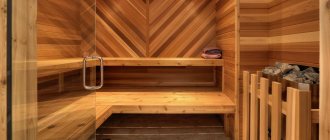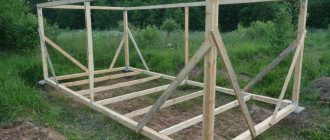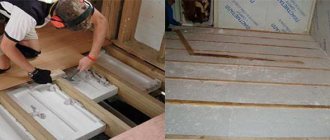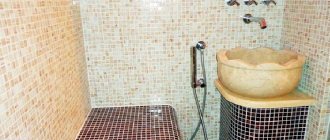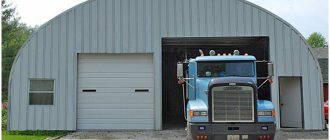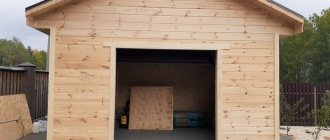Your own sauna is a great place to take a steam bath in the cold. In order to quickly heat and retain heated air in the bathhouse, you need to properly insulate all its surfaces. Particular attention should be paid to the ceiling, since according to the laws of physics, warm air masses rise upward.
Conditions of high temperatures and humidity place special demands on the choice of insulation. When carrying out thermal insulation with your own hands, you also need to take into account what kind of design the ceiling has. Depending on this, it can be insulated from the inside or outside.
Some features of bath insulation
Proper thermal insulation of the bathhouse will help to significantly reduce fuel costs, improve the quality of the procedure, and keep the building itself in good condition for a long time, especially if the bathhouse is used all year round.
Since ancient times, Russian baths have been insulated using natural materials - moss, tow, bast, etc. Nowadays, it is better to use artificial insulation. They are durable, easy to install, and environmentally friendly.
When choosing insulation, it is necessary to take into account the peculiarities of using bath rooms - high levels of moisture, high temperatures, and often live fire. All these points impose certain requirements on bath insulation, especially if they will be used for internal insulation.
Before purchasing material, it is necessary to carefully consider a number of important factors, taking into account cost, biological inertness, and technical characteristics of the proposed heat insulators. Another important point is the regional climate. The amount of materials required is determined by the size of the bathhouse building and the required thickness of the thermal insulation layer.
Whether it is necessary and whether it is possible to insulate a bathhouse from the outside depends on the material from which it is built, the regional climate and the time of use - seasonal or year-round.
Ventilation
The ventilation system allows you to maintain the quality of the air in the bathhouse, the correct thermal conditions, drying, and ventilation. Ventilation provides air exchange. It is carried out through ventilation ducts. Ventilation can also be provided by opening windows.
The size of the ventilation ducts is about 15x20 cm. The first duct is the supply duct, located next to the firebox, at a height of less than half a meter from the floor. Another channel, an exhaust channel, is made on the opposite wall at a distance of about two meters from the floor. A fan can be installed in this channel to speed up ventilation. The channels are closed most of the time with valves of the appropriate size.
Required tools and materials
In order to carry out thermal insulation of a bathhouse yourself, you need to prepare the following set of tools:
- construction tape;
- screwdriver;
- building level and plumb line;
- axe;
- chisel;
- saw or hacksaw;
- hammer;
- jigsaw;
- wire cutters or pliers;
- sharp technical knife;
- electric drill or hammer drill.
In addition to the insulation itself, for work you will need:
- vapor barrier film;
- wooden beam;
- metal rail;
- screws and nails;
- adhesive tape.
Final work
Upon completion of installation of the ceiling insulation elements, the entire structure is covered with a decorative coating. For insulation from the inside, the decorative ceiling is usually made of lining. When insulating, a finished floor is laid on the outside.
- When attaching finished floors or ceilings, a ventilation gap should be left between them and the insulation layer.
- Chipboard or plywood sheets cannot be used for decorative ceilings. At high temperatures in the steam room, the adhesives contained in them release harmful substances.
- If the attic space above the steam room is not intended to be used, then you can not cover the thermal insulation at all, leaving it covered only with a moisture-proofing film.
How to choose insulation
The bathhouse usually has: a dressing room, washing rooms, a steam room, a dressing room, and a relaxation room. These rooms have different levels of humidity and temperature during washing. Therefore, how you can insulate a bathhouse inside is determined for each room separately.
According to their mechanical characteristics, insulation materials are divided into bulk, block and tile, matte and fibrous materials.
The chemical composition makes it possible to divide heat insulators into organic, inorganic, technical and plastic materials.
Plastic-based heat insulators are best used for insulating rooms with low levels of moisture and temperatures. They are not used in the steam room due to their easy flammability and deformation when heated. Cheap and safe organic heat insulators can be used in a steam room only after fire prevention treatment.
Inorganic heat insulators are considered the most practical. These materials are fire resistant and non-hygroscopic. They do not rot and can serve for a long time without losing their basic technical properties.
Selecting a skin
Is it possible to cover a steam room with plastic rather than wood? Yes. But steaming will not be comfortable. Not even any type of wood is suitable for such premises. Preference is given to linden, alder, aspen and abash. When heated, such wood maintains a temperature close to 36 degrees, does not darken, and does not burn human skin. After steam treatment, a pleasant smell specific to each tree is released. The choice of wood depends only on the taste of a particular person.
Lining with foil in the steam room
Article on the topic - penofol insulation.
To preserve the characteristic properties of the finish, each element is necessary in advance:
- Cut to size;
- Plan, rounding the corners of the workpieces;
- Sand, drilling the fastening points with nails;
- Impregnate with a solution (borax, sodium fluoride);
- Dry at a temperature of 60 degrees until the humidity does not exceed 10 degrees;
- Saturate the brush generously with a water-repellent compound (heavily diluted PF varnish).
More about vapor barriers
The most successful vapor barrier option for all sauna rooms is aluminum foil. It is fire-resistant, durable, non-hygroscopic. The main advantage of aluminum foil is its ability to reflect heat. By using such a vapor barrier in a bathhouse, you can significantly reduce the consumption of fuel material.
Glassine and roofing felt cannot be used in the steam room, since these materials, when heated, emit volatile toxic substances. In some cases, glassine can be used as insulation. It is better not to use roofing material for this purpose at all.
Glass wool
This is the same mineral wool. As a candidate for ceiling insulation in a bathhouse, it has the same excellent characteristics as basalt wool. But there is one significant “but”.
Glass wool fibers are extremely brittle and can crumble into microscopic filaments that can even penetrate under a person's clothing and cause severe itching.
Glass wool
What can we say about a bathhouse where a person is without clothes at all?
Conclusion: if there is anything to cover the ceiling in a bathhouse with, it’s not glass wool.
We examined all lightweight types of insulation and determined that only basalt mineral wool is suitable for a suspended ceiling in a bathhouse.
Internal insulation of the bath
The choice of insulation and the method of its installation depend on the material from which the bathhouse is built. If the bathhouse is built from timber, a cellular sheathing of timber is first installed on the load-bearing walls. The cross-section of the timber should be 0.2-0.3 cm greater than the thickness of the heat insulator. This will ensure the safety of the insulation and its useful properties.
The selected heat insulator is placed between the sheathing beams. It is covered with a vapor barrier material. The vapor barrier is laid with a shift. A thin metal strip is mounted over the joints. A gap of no more than 3 cm must be left between the insulation and the vapor barrier.
The corners of the room, pipes, window and door openings are sealed using special vapor barrier tape. This will protect problem areas from moisture penetration.
For finishing in this case it is easier to use clapboard boards. It is stuffed on top of the vertical sheathing.
Bath buildings of panel or frame type are insulated only with heat insulators that have a low specific gravity. Before use, they are treated with lime milk to protect against corrosion and increase fire resistance. After processing, the material must be thoroughly dried.
Outside
It does not allow water to pass through, is resistant to temperature changes, durable and has low thermal conductivity.
Next, about insulating the walls of a bathhouse from the outside with your own hands.
This is why penoplex is considered one of the best synthetic materials.
To insulate walls made of logs and logs, natural materials are most often used; in turn, for a frame or bathhouse made of blocks, penoplex is ideal.
Attention! Penoplex has average fire resistance, and during combustion it releases toxic substances. That is why it is unacceptable to use it for internal insulation of a bathhouse.
Let's look at the process of insulating a bathhouse from the outside step by step:
Let's look at the process of insulating a bathhouse from the outside step by step:
- The first step is to clean the walls of any kind of contamination, such as paint residues, dust or dirt;
- Next, the surface of the wall should be coated with a primer in two layers;
- When the applied layers have dried, the vapor barrier layer can be fixed;
- Next, glue is applied to the foam sheet; the thickness of the insulation layer should be at least 7 cm;
- The sheet is attached to the wall and additionally secured with “fungi”;
- After the wall surface is completely covered with the first layer of insulation, you can proceed to arranging the second layer. To do this, the foam sheets must be placed in such a way as to overlap the seams of the first layer;
- When the glue is completely dry, you can begin sealing the gaps with sealant or foam;
- Next, you should strengthen the structure with a fiberglass mesh attached on top of the second layer with glue;
- The final stage is plastering the walls, as well as further finishing.
Don't forget about wind protection.
To protect the walls and the thermal insulation itself from precipitation, wind and condensation, waterproof, windproof membranes are used.
This protects the wall and thermal insulation.
They are laid on the outside of the insulating layer directly under the building's cladding and secured using a construction stapler.
We insulate the steam room
The steam room in the bathhouse requires special attention. After all, it is here that the highest level of moisture and elevated temperature are observed during operation. Therefore, insulation, waterproofing and finishing of this room must be done with special materials.
The ceiling of the steam room is subject to maximum heating during operation (up to 150 °C). Therefore, the question of how to insulate the ceiling of a bathhouse is solved by using materials with high heat resistance.
If there is no attic or attic, insulation is installed in the following order:
- wooden lattice made of timber on the ceiling boards;
- sheathing elements;
- thermal insulation;
- vapor barrier.
If there is an upper room - an attic, an attic - the insulation scheme looks slightly different. A layer of clay at least 2 cm thick is applied to the ceiling boards. This will ensure moisture retention. All small holes, joints between boards, etc. are filled with bulk material. Typically, expanded clay or wood chips are used for this. The thickness of this layer is at least 20 cm.
A box-shaped base of rafter supports is mounted on the ceiling around the chimney. This will provide a gap of 20 cm between the pipe and the heat insulator, required by fire safety. A non-flammable heat insulator such as glass wool or mineral wool is placed inside the box. The main surface of the ceiling is covered with a layer of mineral heat insulator.
Functions of the waiting room
This room in the bathhouse can perform different functions, but the main ones are:
- Water procedures after the steam room. Everyone knows that after a steam room you need to plunge into cold water or douse yourself with it, as this has a positive effect on human health. If the bathhouse does not have a pool, then you can douse yourself with water from a barrel in the dressing room.
- Shower room. There you can wash off the dust in a day and don’t have to go to the bathhouse.
- Storage of utensils. You can store smells, gangs, brooms, etc.
Therefore, this room must be built as comfortable and warm as possible, so that you can relax there after a steam room, drink tea or douse yourself with ice water.
Useful tips
The walls and ceiling of a bathhouse building must be insulated according to the following principles:
- Thermal insulators must be in close contact with the wall surface to reduce the risk of internal moisture and cold air entering.
- A ventilation gap is needed on top of the insulation to dry it.
- All floors and other wooden elements must be treated with an antiseptic composition to prevent premature destruction of the material.
- Materials with a low level of heat and moisture resistance cannot be used in the steam room.
- Insulation materials should be selected from those that do not deform under the influence of moisture and high temperatures and do not emit hazardous chemicals.
Necessary properties of insulation for a bath:
- heat resistance;
- moisture resistance;
- environmental friendliness;
- Fire safety.
Natural insulation materials require special treatment before use. Otherwise, mold, mildew and harmful insects may soon appear. In this case, it is more advisable to use artificial insulation.
How to insulate a dressing room from the inside with your own hands
Photo. Insulated dressing room made of wood
Most often, foil penofol or isolon is used to independently insulate a wooden dressing room. This material allows you to inexpensively and quickly level out the temperature difference in winter between the street and a heated room. The role of additional heat protection can be played by the interior decoration of the walls and ceiling in the dressing room with wooden clapboard or other suitable materials.
It is worth remembering that the stability of temperature in the steam room and comfort in the dressing room depend on the correct choice of thermal insulation and the quality of the insulation.
It is important to know not only how to properly insulate a dressing room from the inside with your own hands, but also how to insulate a dressing room. As thermal insulation, you should choose a moisture-resistant material; if the choice fell on mineral wool or ecowool, then you need to take care of the vapor and waterproofing of the insulation
Polystyrene foam, extruded polystyrene foam, foamed polyurethane foam, mineral wool or glass wool are used as thermal insulation for the dressing room. Foamed polyurethane foam and expanded polystyrene should be considered the ideal material for a dressing room. Due to their high characteristics of moisture resistance and durability, these materials will provide reliable insulation of walls, floors and ceilings of any room.
Application of foam plastic
Many home craftsmen are interested in whether it is possible to insulate a bathhouse with foam plastic. After all, this is a relatively inexpensive and easy-to-use material. However, it should be said that the bathhouse can be insulated with foam plastic from the outside or along the foundation.
When asked whether it is possible to insulate a bathhouse with foam plastic from the inside, most experts will answer negatively. This is due to the fact that foam is easily destroyed when exposed to high temperatures. The low moisture resistance of this material causes it to rot under the influence of high humidity. Therefore, for the interior of a bathhouse, foam plastic can only be used in rooms where there is almost no moisture.
Subtleties of the procedure: from A to Z
It doesn’t matter exactly when you decided to insulate the steam room - at the stage of building the bathhouse itself or after completion of construction. The main thing is to strictly follow the sequence of insulation measures and do not forget about the basic rules of insulation:
- Waterproofing is an essential part of the insulation process. Even if the material does not absorb moisture or form condensation, take full care of the waterproofing layer. Over time, pores may form in the insulation, and water risks “reaching” the outer coating of the bathhouse and accelerating its destruction.
- It is better not to skimp on material for insulating the steam room. The service life depends on this. Basalt will last 30 years, and foam plastic will last only 5-7.
- It is better to secure the insulation with screws or nails. Today there is a large selection of special adhesives, some of them are designed for very high temperatures, but, as practice shows, nothing more reliable and cheaper than a simple nail has yet been invented.
- It is imperative to insulate the floor. If there is no concrete screed, one is made. Top filling with cement or concrete will help extend the service life of the entire steam room and its base, in particular.
- The materials used for working in the bath should be marked that they can be used at elevated temperatures. When heated, some products emit substances that are caustic and dangerous to people. To avoid putting yourself and your loved ones at risk, always read the information on the packaging of the products you purchase.
- The interior lining of the steam room is not painted or varnished. Heating will contribute to the release of toxic fumes, and constant changes in temperature inside the room will lead to the layer becoming externally unattractive and will have to be renewed regularly.
Use of mineral wool
The question of whether it is possible to insulate a bathhouse with mineral wool is usually resolved positively.
After all, mineral wool is an almost universal modern insulation material with many positive technical characteristics. Among them are:
- reliability;
- moisture resistance;
- heat resistance;
- fire safety;
- resistance to rotting;
- easy installation.
Therefore, mineral wool can be used as bath insulation both outside and inside, including a steam room.
Insulating elements
The layered structure of the insulating floor coverings of the dressing room includes the following elements:
- Waterproofing. It is necessary for protection from groundwater and flood waters from the ground, i.e. from below, and to prevent the accumulation of moisture coming from the inside (steam condensation, from shoes in wet weather, from bare wet feet after washing procedures). Waterproofing layers are formed from moisture-proof roll materials (roofing felt, polyethylene film), in the form of a coating of bitumen or mastic. The second component of waterproofing protection is the impregnation of wooden parts, which eliminates the risk of rotting of the material. In addition, the so-called gluing method is used, when the joints of the elements are sealed with tape with an adhesive layer.
- Vapor barrier. When the doors to the steam room are opened, steam penetrates into the dressing room, affecting the material of the floor structure. Taking this into account, the “layer cake” includes a layer that is not permeable to steam. As such protection, films with aluminum foil are widely used. The base of the film can be polyethylene, PVC, polypropylene. In addition, in principle it is possible to use membrane materials that provide vapor tightness.
- Thermal insulation. Reliable thermal insulation of the dressing room floor is considered an urgent need. The thickness of this layer depends on the material used, but on average it is 10-15 cm. The most popular thermal insulation materials are: mineral wool, ecowool, expanded polystyrene, extruded polystyrene foam, expanded clay. One of the cheapest options is sawdust. It should be taken into account that the thermal insulation properties of mineral wool or expanded clay are significantly reduced when moisture penetrates, because It is due to the air gaps that they retain heat. Thus, when using them, the role of waterproofing increases.
Penoplex insulation
Is it possible to insulate a bathhouse from the inside with penoplex? This is quite acceptable taking into account some technical characteristics of the material. Despite having many useful properties, penoplex is a hygroscopic material with low heat resistance.
Therefore, in the steam room it is better to use it only on the walls and be sure to cover it with foil. In other sections of the bath it is quite suitable.
Finishing inside the dressing room
Typically, the finishing material here is lining, and both coniferous and deciduous wood can be used. But even those that successfully resist moisture require mandatory treatment with a fire retardant and antiseptic.
Covering the floor
So:
- Beams are placed on the waterproofing, their thickness is 3-4 cm, the pitch is from 30 to 40 cm.
- The floorboards are attached to the beams using the tongue-and-groove method; near the walls this is done with self-tapping screws, the heads of which must be deepened.
- Rubber mats are used as an additional covering.
We are working on the ceiling and walls
First they tackle the ceiling, then the walls. The work goes according to this scenario:
- the sheathing is installed;
- the first element is attached to the wall opposite the entrance using a nail driven in at an angle of 45°;
- after checking the level, the following parts are installed;
- beams, the thickness of which is 4 cm, are attached to the wall;
- the covering starts from the corner, the actions are similar to ceiling installation;
- The last stage is fastening the skirting boards and installing the platbands.
The dressing room is ready, now all that remains is to think about how to decorate its interior. Others believe that we should not forget the traditions of our ancestors, while others strive for novelty in everything.
It’s not difficult to build a dressing room in a bathhouse with your own hands, and if you built the bathhouse yourself, then the operation won’t even take you much time.
Bathroom floor insulation
The floor in the bathhouse is usually made of wooden boards or concrete. The board is used in relatively dry rooms. Concrete - in the washing room and in the steam room. The technology of floor insulation depends on the base material.
To insulate a concrete floor, expanded clay (3-5 mm), extruded polystyrene or boiler slag are most often used. The upper level of the floor at the end of the insulation work is 15-20 cm. The work is carried out in the following order.
The concrete base must be leveled and cleared of construction debris and dust. Next, an adhesive composition is applied to the surface in 2-3 layers. Most often, special mastics are used for this, for example, rubber-concrete. A waterproofing agent – high-strength polyethylene or roofing felt – is placed on the adhesive composition.
After the waterproofing has set, the installation of insulation begins. An adhesive composition is again applied on top of it, on which the waterproofing material is laid. The last layer is a reinforced concrete screed, at least 30 mm thick. The concrete must be leveled and dried properly. The final finishing of such a floor is usually done using ceramic tiles. Under it you can place a heated floor system.
To insulate a wooden floor, you must first remove the old boards. A cranial beam is placed on the remaining beams from below. It must be wrapped in roofing felt or heavy-duty polyethylene. A rough floor covering is laid on top of the waterproofing material. For this purpose, bulk materials or mineral wool are mainly used. Is it possible to insulate the floor in a bathhouse using isopink? It is possible if the floor is wooden and is located in a room with a low level of moisture.
A waterproofing material is applied over the insulation. Then the finished floor board is laid. A plinth is attached around the perimeter of the room. The final paint coating is not used in this case, since these materials release toxins under the influence of temperature and moisture. If desired, the wooden floor can be covered with special rubberized mats. They will make the room cozy and will not cause much trouble when cleaning. The floor in the bathhouse is insulated mainly for greater user comfort. Floor insulation has little effect on the overall temperature inside the bath rooms.
Vapor barrier: which is better?
membranes, foil and foil materials, films can be used as a vapor barrier In principle, if there was no need to protect the thermal insulation layer, then the need for vapor barrier would disappear - the matter would be limited to ventilation and that’s all.
The main battles, of course, are over
foil. We recommend reading our article, which provides arguments regarding which vapor barrier is best for a steam room in a bathhouse.
In general, the need for foil, as well as the harm from it, cannot be considered unambiguous statements. Because a lot depends on what bath regime a person prefers. And it turns out that what is good for one is detrimental for another.
If we talk exclusively about vapor barrier, without reflecting infrared radiation, then foil is an excellent insulator; it does not allow steam to pass through completely. True, condensation falls on its surface and rolls down, but that’s why we leave the ventilation gap in order to ventilate the lining and prevent it from rotting from this moisture.
Membranes are different: single- and multi-layer, single- and double-sided, multifunctional... The essence of their action is not to allow steam to pass to the thermal insulator, but to pass in the opposite direction, allowing it to release absorbed water vapor from somewhere else.
Multifunctional membranes also act as both a heat and water insulator, and therefore are expensive. In multi-layered ones, moisture accumulates between the layers and then gradually evaporates.
Films are also different, so it is best to ask sellers what temperature they are designed for. You need ones that can withstand 100 degrees and above.


